How To Make A Minecraft 1.19.2 Server
Creating and playing Minecraft on a 1.19.2 server is a great way to experience the Wild Update with friends or a community. This version introduces new biomes, mobs, and gameplay features—making it a perfect time to host your own Minecraft world. Whether you're on a VPS or using a shared SparkedHost server, this guide walks you through how to download the server jar, configure the right folder structure, and launch your own instance from your desktop or VPS/dedicated server.
Key Features of Version 1.19.2 (and 1.19 Overall)
Minecraft 1.19.2 is part of the Wild Update, building on the features introduced in 1.19 while adding important bug fixes and stability improvements. While 1.19.2 itself is a minor update, it supports all the core content from 1.19, which introduced exciting new blocks, mobs, and biomes to the game.
- The Deep Dark biome: A spooky underground biome featuring new sculk blocks and intense atmosphere
- The Warden: A powerful, blind mob that reacts to sound and vibration—designed to be avoided, not fought
- Ancient Cities: Mysterious structures found in the Deep Dark, loaded with loot, file-based lore, and server gameplay potential
- The Mangrove Swamp biome: A lush, new swamp variant with mangrove trees, muddy terrain, and unique vegetation
- Frogs and Tadpoles: New passive mobs with biome-specific variations and frogspawn mechanics
- Sculk Sensor blocks: Redstone components that detect vibration, adding new mechanics for stealth and automation
- Boat with Chest: A simple but useful new game item for transporting items over water
How to Change Your Minecraft Server Version to 1.19.2
Thankfully, making a basic server on a Sparked Host server is easy.
To make a Minecraft server that runs on version 1.19.2:
- Shutdown your Minecraft server.
- Select versions on the righthand side
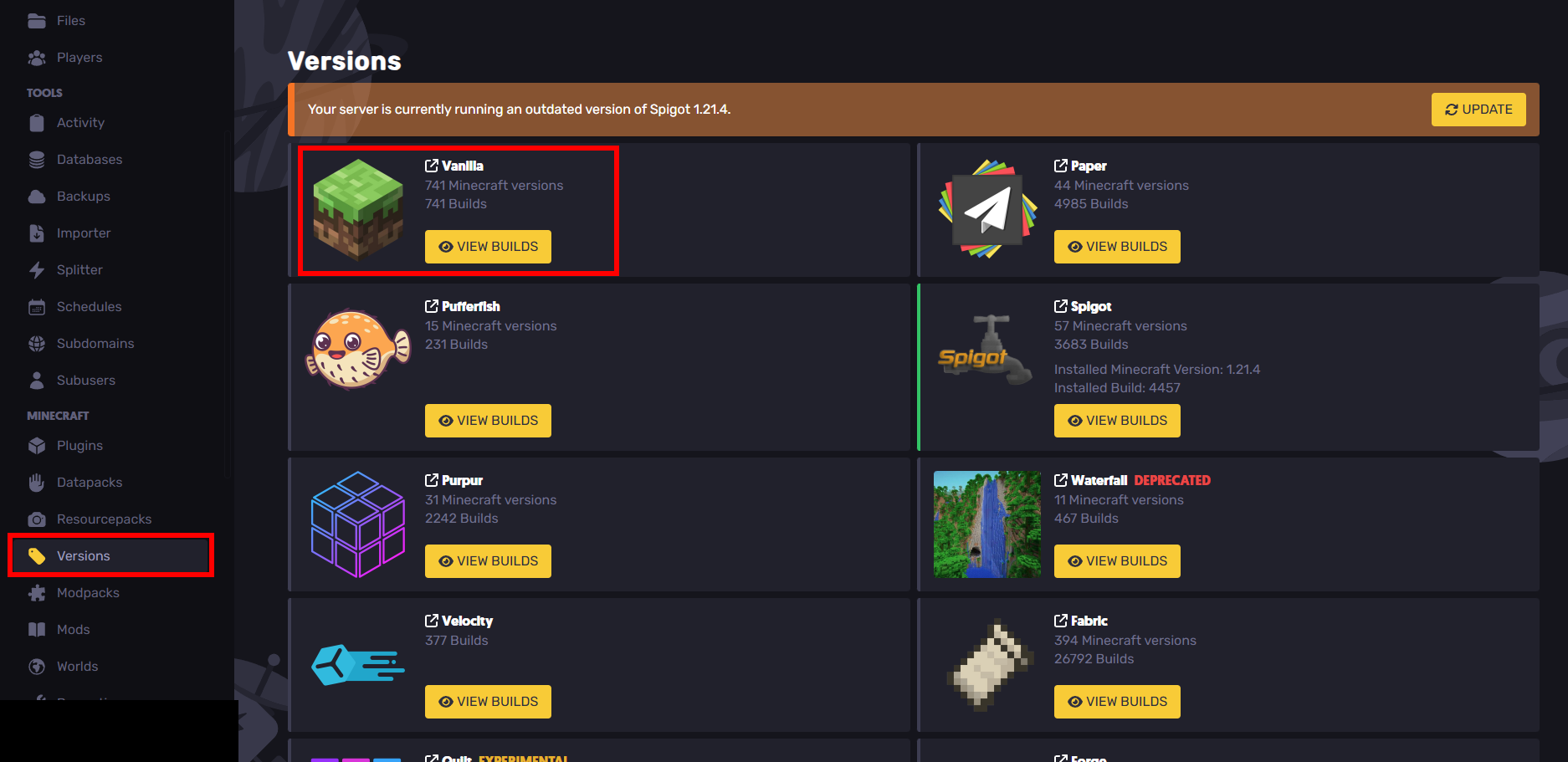
- Click on
VIEW BUILDSforVanilla
- Scroll down and select 1.19.2

- Press install. Do note that if you had another version before that you were playing on, you should backup those files.
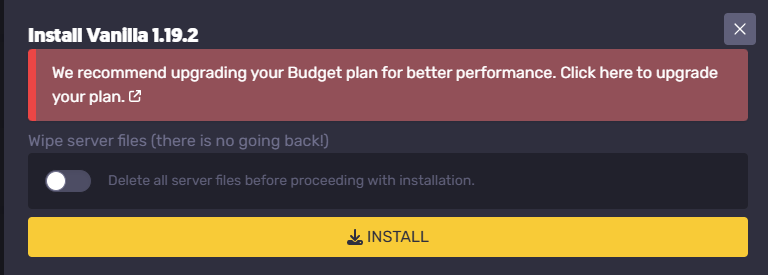
- Restart your server
How to Make a Minecraft 1.19.2 Server on a VPS
Minecraft servers can be run on Windows, macOS, GNU/Linux, and BSD operating systems. This tutorial assumes that you're on a Linux system operating system for your VPS. If you're on windows, this won't help.
This process will be a little more difficult if you don't know linux commands. It's good to know the basic commands like cd and ls before proceeding. If you want to learn more about Linux commands, see https://pwn.college/linux-luminarium/ (free linux course!).
However, if you don't know these commands, you can blindly follow this tutorial no problem either way.
Setting Up Java
Having Java installed is **required to run a Minecraft 1.19.2 server on a VPS. **
For this Minecraft version, we'll at least want a Java version of at least Java 17 installed. For this tutorial, we'll have the latest version of Java installed so that if you wanted to switch the version of your Minecraft server, you can.
Also there are some performance benefits with Java 24 (see here: https://www.youtube.com/watch?v=oTc16DAMTqg)
Here are some quick terms that are good to know:
- Java Virtual Machine (JVM) - Interprets the java code.
- Java Runtime Environment (JRE) - Used to run java programs, can't be used to create them. You'll need this to run your Minecraft server. Includes the JVM as well.
- Java Development Kit (JDK) - Used to create java programs. Installing a JDK will include a JRE.
You might also have java already installed. Check if you do with the command in the command line:
java --version
If it's greater than 17 then you can skip this part of the tutorial. However, if you're running mods then you might want to consider lowering the version if the mod requires it.
For this tutorial, we'll install the lastest version of Java at https://www.oracle.com/java/technologies/downloads/.
Choose the download based off of what CPU architecture you have.
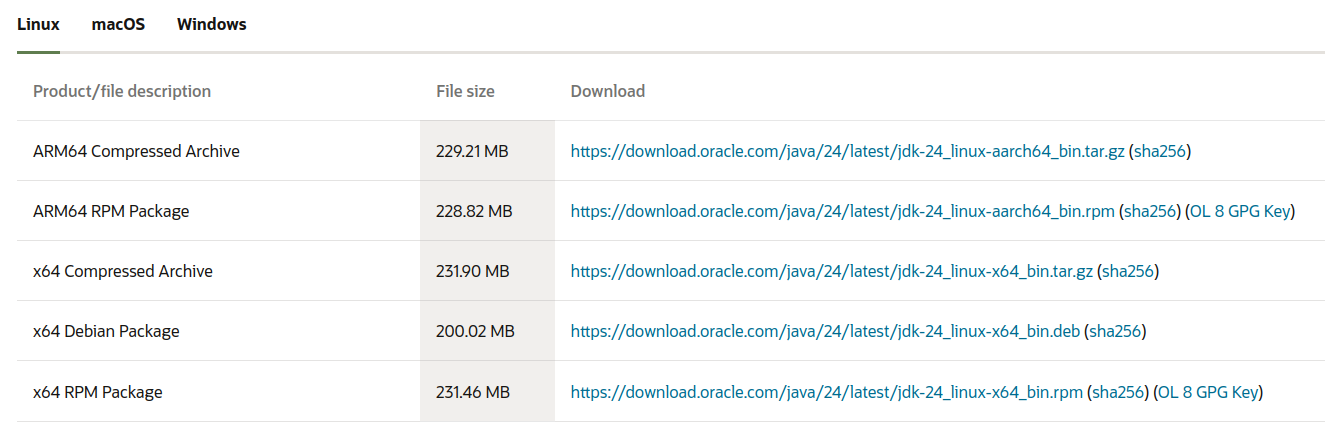
You can determine this with the command (in the image example: x86_64 = I would install the x64 compressed archive):
uname -p

Also, download the Compressed Archive type because it's easier to decompress (unless you know what you're doing of course).
Once it installs, decompress it with:
tar -xzvf jdk-24_linux-x64_bin.tar.gz
(Replace jdk-24linux-x64_bin.tar.gz with the file name)_
Although this is now installed, we'll need to add this to PATH. In my example, I already had java 21 installed and I'm replacing it with java 24.
First, I echoed the PATH environment variable:

echo $PATH
Next, I:
- Got the current directory
pwd
- Rewrote the path variable with what it was before except I removed and replaced the older java version with the newer one I installed.
/home/julian/.sdkman/candidates/java/current/bin:/usr/local/sbin:/usr/local/bin:/usr/sbin:/usr/bin:/sbin:/bin:/usr/games:/usr/local/games:/snap/bin:/snap/bin
became
/home/julian/Downloads/jdk-24/bin:/usr/local/sbin:/usr/local/bin:/usr/sbin:/usr/bin:/sbin:/bin:/usr/games:/usr/local/games:/snap/bin:/snap/bin
With the
export PATH=
command.
Be very careful with what you set this command to because it can mess up other commands if set improperly.

After that, check your version with:
java --version
If the path was set properly then it should work!
Downloading the 1.19.2 Minecraft Server File
First go to https://www.minecraft.net/en-us/article/minecraft-java-edition-1-19-2 and install the Minecraft server jar file.
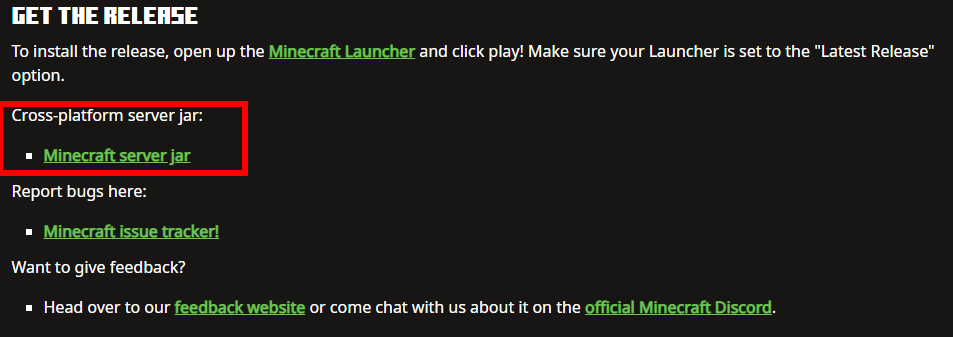
After installing, open the command line and cd into your Downloads folder (or wherever it downloaded) and mkdir a new directory to store your Minecraft server files in. mov the jar into that new folder.

Starting Your Server
cd into the folder that you moved your server jar into. To get your Minecraft server running, run the server jar file with java -jar server.jar (replace server.jar with the name of the server jar file if it's different). You can also run this command with the flag -nogui if you don't want any gui (say, you're running remotely).
The Minecraft server requires you to accept the EULA (end user license agreement) before it can run:
[16:04:38] [ServerMain/INFO]: You need to agree to the EULA in order to run the server. Go to eula.txt for more info.
Edit the eula.txt file with your preferred editor and change the eula variable to true. I used nano (please don't get mad vim supremacists).
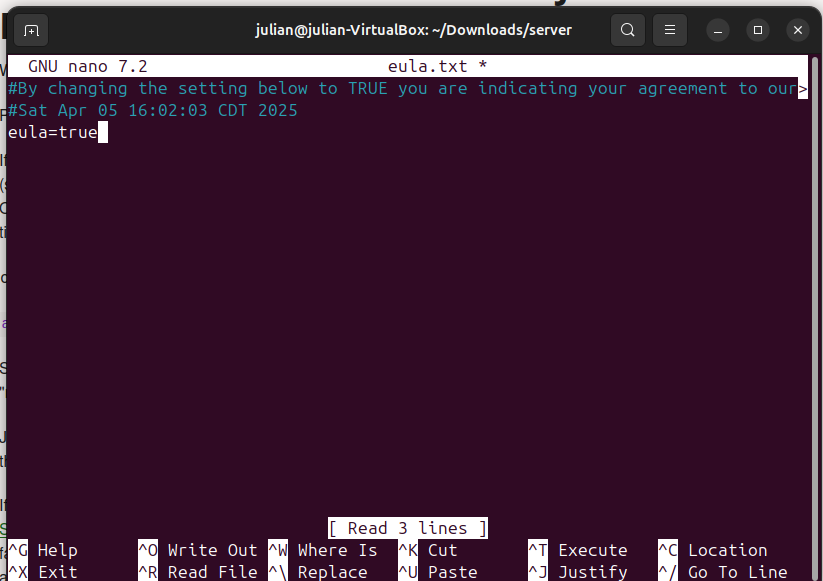
Then, rerun your server. It should start creating your world files and generating the world.
If it's stuck at 0% for a while, you might need to allocate more ram. This can be done with adding the flags -Xms and -Xmx to your command. -Xms changes the starting memory and -Xmx changes the max memory.
For example:
java -jar -Xms2048M -Xmx2048M
Changing Server Settings
- Shutdown your server by sending
stoporCtr+C
- Use
vimornanoto openserver.properties(your server properties file)
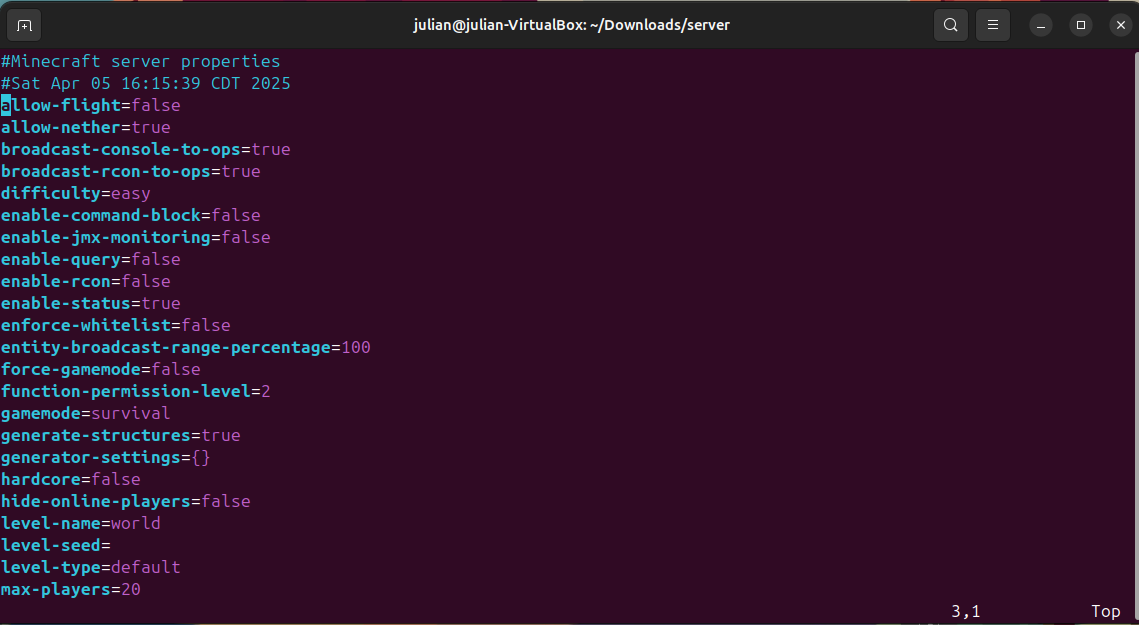
- Edit
- Save
- Restart the server
Setting Up Port Forwarding
*Port forwarding is important if you want users on different networks to run Minecraft and play on your server. It comes with some caveats and you will have to share your IP address which might be problematic. This is why we recommend using a VPS or a dedicated server. *
The default port for Minecraft servers is 25565. This can be changed in server.properties.
We'll also enable the firewall and add the port before we forward through the router (we need to allow the port so that others can connect). If your system is debian based the firewall is ufw (uncomplicated firewall):
sudo ufw enable
cat server.properties | grep server-port
sudo ufw allow 25565

(Of course, replace 25565 with the port number that server.properties has)
After the port has been added to the firewall, devices in your local network should be able to join (but not devices outside that!). We'll have to change some browser settings to allow other users from other networks to join.
Access your router in the browser with your router's IP address. (This is the default gateway address when you do ipconfig on a windows machine or route -n on a linux machine)
For this tutorial I'm using an AT&T router.

- Go to "Firewall"
- Go to NAT/Gaming
- Go to Custom Services and create a new service
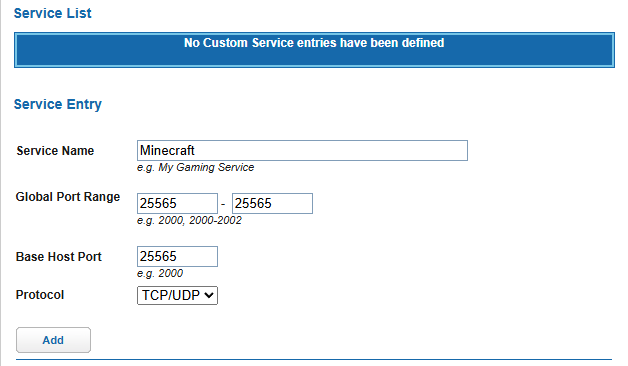
- Add go back and then select the service as the custom service that you added. Then select the device that's running the server. I'm using a virtual machine which is why I selected vbox.

How To Connect To Your 1.19.2 server
To connect to your Minecraft 1.19.2 server:
- Open Minecraft version 1.19.2 in the Minecraft launcher
- Obtain the local IP of the server with the command ( If you want to connect from the SAME network / localhost):
ifconfig | grep -Eo 'inet (addr:)?([0-9]*\.){3}[0-9]*' | grep -Eo '([0-9]*\.){3}[0-9]*' | grep -v '127.0.0.1'
(From StackOverflow)
If you want to connect from a different network, go to https://whatismyipaddress.com/ and use that address.
- Open Minecraft add the server IP under "add server" , If your server port is a different port from the traditional 25565 for connections, then you'll need to append
:1234to the end of it (replace 1234 with your actual server port) - Join and connect to the Minecraft server
Still have some questions?
If you had any issues or failed to do port fowarding, you can contact SparkedHost at https://sparkedhost.com/contact. Make sure to also include any error messages in your help ticket.
Also, you can join our discord server at https://discord.com/invite/sparked where you can get your problems fixed fast.
By: Julian T.
Updated on: 03/11/2025
Thank you!